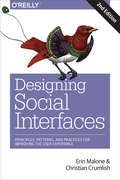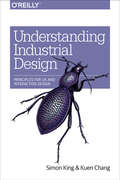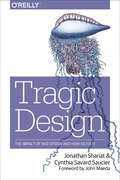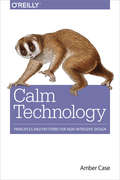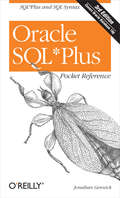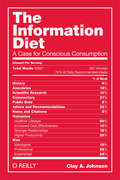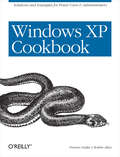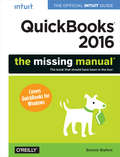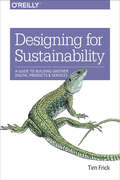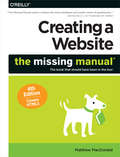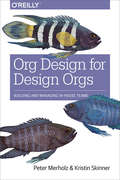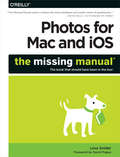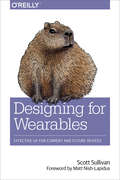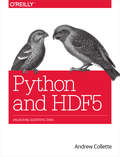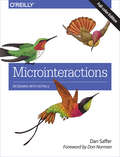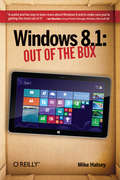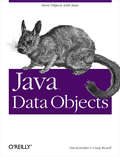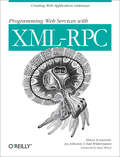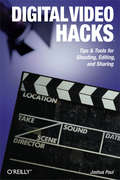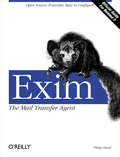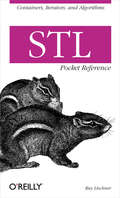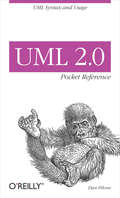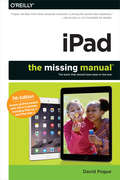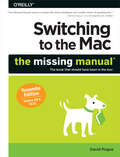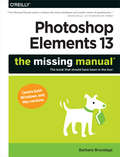- Table View
- List View
Designing Social Interfaces: Principles, Patterns, and Practices for Improving the User Experience (Animal Guide Ser.)
by Christian Crumlish Erin MaloneDesigners, developers, and entrepreneurs today must grapple with creating social interfaces to foster user interaction and community, but grasping the nuances and the building blocks of the digital social experience is much harder than it appears. Now you have help.In the second edition of this practical guide, UX design experts Christian Crumlish and Erin Malone share hard-won insights into what works, what doesn’t, and why. With more than 100 patterns, design principles, and best practices, you’ll learn how to balance opposing forces and grow healthy online communities by co-creating the experience with your users.Understand the overarching principles before applying tactical design patternsCultivate healthy participation and rein in misbehaving usersLearn patterns for adding social components to an existing siteEncourage users to interact with one another, whether it’s one-to-one or many-to-manyUse a rating system to build a social experience around products or servicesOrchestrate collaborative groups and discover the real power of social networksExplore numerous examples of each pattern, with an emphasis on mobile appsLearn how to apply social design patterns to enterprise environments
Understanding Industrial Design: Principles for UX and Interaction Design
by Kuen Chang Simon KingWith the coming flood of connected products, many UX and interaction designers are looking into hardware design, a discipline largely unfamiliar to them. If you're among those who want to blend digital and physical design concepts successfully, this practical book helps you explore seven long-standing principles of industrial design.Two present and former design directors at IDEO, the international design and innovation firm, use real-world examples to describe industrial designs that are sensorial, simple, enduring, playful, thoughtful, sustainable, and beautiful. You'll learn how to approach, frame, and evaluate your designs as they extend beyond the screen and into the physical world.Sensorial: create experiences that fully engage our human sensesSimple: design simple products that provide overall clarity in relation to their purposeEnduring: build products that wear well and live on as classicsPlayful: use playful design to go beyond functionality and create emotional connectionsThoughtful: observe people's struggles and anticipate their needsSustainable: design products that reduce environmental impactBeautiful: elevate the experience of everyday products through beauty
Tragic Design: The Impact of Bad Product Design and How to Fix It
by Cynthia Savard Saucier Jonathan ShariatBad design is everywhere, and its cost is much higher than we think. In this thought-provoking book, authors Jonathan Shariat and Cynthia Savard Saucier explain how poorly designed products can anger, sadden, exclude, and even kill people who use them. The designers responsible certainly didn’t intend harm, so what can you do to avoid making similar mistakes?Tragic Design examines real case studies that show how certain design choices adversely affected users, and includes in-depth interviews with authorities in the design industry. Pick up this book and learn how you can be an agent of change in the design community and at your company.You’ll explore:Designs that can kill, including the bad interface that doomed a young cancer patientDesigns that anger, through impolite technology and dark patternsHow design can inadvertently cause emotional painDesigns that exclude people through lack of accessibility, diversity, and justiceHow to advocate for ethical design when it isn’t easy to do soTools and techniques that can help you avoid harmful design decisionsInspiring professionals who use design to improve our world
Calm Technology: Principles and Patterns for Non-Intrusive Design
by Amber CaseHow can you design technology that becomes a part of a user's life and not a distraction from it? This practical book explores the concept of calm technology, a method for smoothly capturing a user's attention only when necessary, while calmly remaining in the background most of the time. You'll learn how to design products that work well, launch well, are easy to support, easy to use, and remain unobtrusive.Author Amber Case presents ideas first introduced by researchers at Xerox PARC in 1995, and explains how they apply to our current technology landscape, especially the Internet of Things. This book is ideal for UX and product designers, managers, creative directors, and developers. You'll learn:The importance and challenge of designing technology that respects our attentionPrinciples of calm design--peripheral attention, context, and ambient awarenessCalm communication patterns--improving attention through a variety of sensesExercises for improving existing products through calm technologyPrinciples and patterns of calm technology for companies and teamsThe origins of calm technology at Xerox PARC
Oracle SQL*Plus Pocket Reference: A Guide to SQL*Plus Syntax (Pocket Reference (O'Reilly))
by Jonathan GennickThe Oracle SQLPlus Pocket Reference is a must-have for anyone working with Oracle databases, especially those looking to maximize the effectiveness of SQLPlus. As Oracle's long-standing interactive query tool, SQLPlus is available at every Oracle site, from the largest data warehouse to the smallest single-user system. Despite its wide use, however, SQLPlus is still often not completely understood or fully utilized.Database administrators and developers alike will therefore find the Oracle SQLPlus Pocket Reference to be extremely beneficial. In addition to summarizing all of the SQLPlus syntax and format options, including new Oracle Database 10g features, this handy, on-the-job guide specifically shows readers how to:Differentiate between SQL and SQLPlusInteract with SQLPlus from both the command line and the web browserSelect, insert, update, and delete dataFormat both text and HTML reports with SQLPlusSpecify SQLPlus commands and format elementsTune SQL queriesThe new third edition of this book has been updated for Oracle Database 10g to include information on both SQLPlus and SQL. New SQL information includes the SELECT statement's new MODEL clause, flashback queries, partition outer joins, and DBMS_XPLAN.With its quick-reference format and compact size, the Oracle SQLPlus Pocket Reference follows in the long line of successful "pocket references" offered by O'Reilly. It also serves as the ideal companion to O'Reilly's larger, more comprehensive book on SQLPlus, the bestselling Oracle SQLPlus: The Definitive Guide.Author Jonathan Gennick is an editor for O'Reilly specializing in database and programming titles, having amassed some 17 years of programming and database management experience.
The Information Diet: A Case for Conscious Comsumption
by Clay A. JohnsonThis is a softcover version of the title released in 2011; there is no new material.The modern human animal spends upwards of 11 hours out of every 24 in a state of constant consumption. Not eating, but gorging on information ceaselessly spewed from the screens and speakers we hold dear. Just as we have grown morbidly obese on sugar, fat, and flour—so, too, have we become gluttons for texts, instant messages, emails, RSS feeds, downloads, videos, status updates, and tweets.We're all battling a storm of distractions, buffeted with notifications and tempted by tasty tidbits of information. And just as too much junk food can lead to obesity, too much junk information can lead to cluelessness. The Information Diet shows you how to thrive in this information glut—what to look for, what to avoid, and how to be selective. In the process, author Clay Johnson explains the role information has played throughout history, and why following his prescribed diet is essential for everyone who strives to be smart, productive, and sane.In The Information Diet, you will:Discover why eminent scholars are worried about our state of attention and general intelligence. Examine how today’s media—Big Info—give us exactly what we want: content that confirms our beliefs. Learn to take steps to develop data literacy, attention fitness, and a healthy sense of humor. Become engaged in the economics of information by learning how to reward good information providers. Just like a normal, healthy food diet, The Information Diet is not about consuming less—it’s about finding a healthy balance that works for you
Windows XP Cookbook: Solutions and Examples for Power Users & Administrators
by Preston Gralla Robbie AllenEach year, Windows XP is pre-installed on 30 million PCs sold in the U.S.--and 90 million worldwide--making it the world's most popular operating system, and proving to frustrated users everywhere that preponderance does not equate to ease of use. There are literally thousands of programs, tools, commands, screens, scripts, buttons, tabs, applets, menus, and settings contained within Windows XP. And it has only been in the last couple of years that Microsoft's documentation has actually been more of a help than a hindrance. But it still isn't enough. Windows XP users and administrators need a quick and easy way to find answers. Plenty of books go into detail about the theory behind a particular technology or application, but few go straight to the essentials for getting the job done. Windows XP Cookbook does just that, tackling the most common tasks needed to install, manage, and support Windows XP. Featuring a new twist to O'Reilly's proven Cookbook formula, this problem-solving guide offers multiple solutions for each of its 300-plus recipes. Solve dilemmas with the graphical user interface, the command line, through the Registry, or by using scripts. Each step-by-step recipe includes a discussion that explains how and why it works. The book is also among the first to cover Microsoft's XP Service Pack 2. With these practical, on-the-job solutions, Windows XP Cookbook will save you hours of time searching for answers. Windows XP Cookbook will be useful to anyone that has to use, deploy, administer, or automate Windows XP. But this isn't a typical end-user book; it covers the spectrum of topics involved with running Windows XP in both small and large environments. As a result, IT professionals and system administrators will find it a great day-to-day reference. And power users will find Windows XP Cookbook a great source for information on tweaking XP and getting the most out of their systems. The bottom line is that Windows XP Cookbook will make just about anyone who uses XP more productive.
QuickBooks 2016: The Official Intuit Guide to QuickBooks 2016
by Bonnie BiaforeHow can you make your bookkeeping workflow smoother and faster? Simple. With QuickBooks 2016: The Missing Manual (which covers the Windows version of QuickBooks), you’re in control: you get step-by-step instructions on how and when to use specific features, along with basic bookkeeping and accounting advice to guide you through the learning process. Discover new and improved features like the Insights dashboard and easy report commenting.The important stuff you need to know:Get started fast. Quickly set up accounts, customers, jobs, and invoice items.Follow the money. Track everything from billable and unbillable time and expenses to income and profit.Keep your company financially fit. Examine budgets and actual spending, income, inventory, assets, and liabilities.Gain insights. Open a dashboard that highlights your company’s financial activity and status the moment you log in.Spend less time on bookkeeping. Create and reuse bills, invoices, sales receipts, and timesheets.Find key info. Use QuickBooks’ Search and Find features, as well as the Vendor, Customer, Inventory, and Employee Centers.
Designing for Sustainability: A Guide to Building Greener Digital Products and Services
by Tim FrickPixels use electricity, and a lot of it. If the Internet were a country, it would be the sixth largest in terms of electricity use. That's because today's average web page has surpassed two megabytes in size, leading to slow load times, frustrated users, and a lot of wasted energy. With this practical guide, your web design team will learn how to apply sustainability principles for creating speedy, user-friendly, and energy-efficient digital products and services.Author Tim Frick introduces a web design framework that focuses on four key areas where these principles can make a difference: content strategy, performance optimization, design and user experience, and green hosting. You'll discover how to provide users with a streamlined experience, while reducing the environmental impact of your products and services.Learn why 90% of the data that ever existed was created in the last yearUse sustainability principles to innovate, reduce waste, and function more efficientlyExplore green hosting, sustainable business practices, and lean/agile workflowsPut the right things in front of users at precisely the moment they need them--and nothing moreIncrease site search engine visibility, streamline user experience, and make streaming video more efficientUse Action Items to explore concepts outlined in each chapter
Creating a Website: The Missing Manual
by Matthew MacdonaldYou can easily create a professional-looking website with nothing more than an ordinary computer and some raw ambition. Want to build a blog, sell products, create forums, or promote an event? No problem! This friendly, jargon-free book gives you the techniques, tools, and advice you need to build a site and get it up on the Web.The important stuff you need to know:Master the basics. Learn HTML5, the language of the Web.Design good-looking pages. Use styles to build polished layouts.Get it online. Find a reliable web host and pick a good web address.Use time-saving tools. Learn free tools for creating web pages and tracking your visitors.Attract visitors. Make sure people can find your site through popular search engines like Google.Build a community. Encourage repeat visits with social media.Bring in the cash. Host Google ads, sell Amazon's wares, or push your own products that people can buy via PayPal.Add pizzazz. Include audio, video, interactive menus, and a pinch of JavaScript.
Org Design for Design Orgs: Building and Managing In-House Design Teams
by Peter Merholz Kristin SkinnerDesign has become the key link between users and today's complex and rapidly evolving digital experiences, and designers are starting to be included in strategic conversations about the products and services that enterprises ultimately deliver. This has led to companies building in-house digital/experience design teams at unprecedented rates, but many of them don't understand how to get the most out of their investment. This practical guide provides guidelines for creating and leading design teams within your organization, and explores ways to use design as part of broader strategic planning.You'll discover:Why design's role has evolved in the digital ageHow to infuse design into every product and service experienceThe 12 qualities of effective design organizationsHow to structure your design team through a Centralized PartnershipDesign team roles and evolutionThe process of recruiting and hiring designersHow to manage your design team and promote professional growth
Photos for Mac and iOS: The Missing Manual
by Lesa SniderApple's new Photos app lets you do a whole lot more than simply store and edit pictures and videos on a Mac or iOS device. With this comprehensive guide, you'll learn how to import, organize, and share your digital memories, as well as how to improve, print, and use your photos in creative projects. With Lesa Snider's step-by-step instructions and expert advice, you'll master Photos and tame your image library--and have fun along the way!The important stuff you need to know:Migrate from iPhoto. Learn how to make a quick and smooth transition.Organize your collection with ease. Master the many ways to import, group, and categorize images--and set up iCloud Family Sharing.Find your photos quickly. Employ Photos' powerful labeling, keyword and facial recognition features to optimize searches.Sharpen your editing skills. Skillfully use Photos' impressive image- and video-editing tools on your Mac or iOS device.Access photos anywhere. Sync your library to all of your Apple devices so your photos travel with you wherever you go.Share them online. Show your shots to everyone on your list by using shared albums, creating web galleries, posting them on Facebook, and more.Dive into creative projects. Build pro-level slideshows to share with others, and create gorgeous gift books, calendars, and cards.
Designing for Wearables: Effective UX for Current and Future Devices
by Scott SullivanNow may be the perfect time to enter the wearables industry. With the range of products that have appeared in recent years, you can determine which ideas resonate with users and which don’t before leaping into the market. In this practical guide, author Scott Sullivan examines the current wearables ecosystem and then demonstrates the impact that service design in particular will have on these types of devices going forward.You’ll learn about the history and influence of activity trackers, smartwatches, wearable cameras, the controversial Google Glass experiment, and other devices that have come out of the recent Wild West period. This book also dives into many other aspects of wearables design, including tools for creating new products and methodologies for measuring their usefulness.You’ll explore:Emerging types of wearable technologiesHow to design services around wearable devicesKey concepts that govern service designPrototyping processes and tools such as Arduino and ProcessingThe importance of storytelling for introducing new wearablesHow wearables will change our relationship with computers
Python and HDF5: Unlocking Scientific Data
by Andrew ColletteGain hands-on experience with HDF5 for storing scientific data in Python. This practical guide quickly gets you up to speed on the details, best practices, and pitfalls of using HDF5 to archive and share numerical datasets ranging in size from gigabytes to terabytes. Through real-world examples and practical exercises, you'll explore topics such as scientific datasets, hierarchically organized groups, user-defined metadata, and interoperable files. Examples are applicable for users of both Python 2 and Python 3. If you're familiar with the basics of Python data analysis, this is an ideal introduction to HDF5. Get set up with HDF5 tools and create your first HDF5 file Work with datasets by learning the HDF5 Dataset object Understand advanced features like dataset chunking and compression Learn how to work with HDF5's hierarchical structure, using groups Create self-describing files by adding metadata with HDF5 attributes Take advantage of HDF5's type system to create interoperable files Express relationships among data with references, named types, and dimension scales Discover how Python mechanisms for writing parallel code interact with HDF5
Microinteractions: Designing with Details
by Dan SafferIt's the little things that turn a good digital product into a great one. With this full color practical book, you'll learn how to design effective microinteractions: the small details that exist inside and around features. How can users change a setting? How do they turn on mute, or know they have a new email message? Through vivid, real-world examples from today's devices and applications, author Dan Saffer walks you through a microinteraction's essential parts, then shows you how to use them in a mobile app, a web widget, and an appliance. You'll quickly discover how microinteractions can change a product from one that's tolerated into one that's treasured. Explore a microinteraction's structure: triggers, rules, feedback, modes, and loops Learn the types of triggers that initiate a microinteraction Create simple rules that define how your microinteraction can be used Help users understand the rules with feedback, using graphics, sounds, and vibrations Use modes to let users set preferences or modify a microinteraction Extend a microinteraction's life with loops, such as "Get data every 30 seconds"
Windows 8: Out Of The Box
by Mike Halsey<p><i>Windows 8: Out of the Box</i> gives those with little experience using tablets and computers a simple and straightforward guide to using Windows 8. Mike Halsey starts with the basics of getting your computer online and takes you step by step through the trickier parts of set up, using the new Windows 8 interface, and sharing your experiences with family and friends.</p>
Java Data Objects: Store Objects with Ease
by David Jordan Craig RussellThis book, written by the JDO Specification Lead and one of the key contributors to the JDO Specification, is the definitive work on the JDO API. It gives you a thorough introduction to JDO, starting with a simple application that demonstrates many of JDO's capabilities. It shows you how to make classes persistent, how JDO maps persistent classes to the database, how to configure JDO at runtime, how to perform transactions, and how to make queries. More advanced chapters cover optional features such as nont
Programming Web Services with XML-RPC: Creating Web Application Gateways
by Edd Dumbill Joe Johnston Simon St. Laurent Dave WinerHave you ever needed to share processing between two or more computers running programs written in different languages on different operating systems? Or have you ever wanted to publish information on the Web so that programs other than browsers could work with it? XML-RPC, a system for remote procedure calls built on XML and the ubiquitous HTTP protocol, is the solution you've been looking for. Programming Web Services with XML-RPC introduces the simple but powerful capabilities of XML-RPC, which lets you connect programs running on different computers with a minimum of fuss, by wrapping procedure calls in XML and establishing simple pathways for calling functions. With XML-RPC, Java programs can talk to Perl scripts, which can talk to Python programs, ASP applications, and so on. You can provide access to procedure calls without having to worry about the system on the other end, so it's easy to create services that are available on the Web. XML-RPC isn't the only solution for web services; the Simple Object Access Protocol (SOAP) is another much-hyped protocol for implementing web services. While XML-RPC provides fewer capabilities than SOAP, it also has far fewer interoperability problems and its capabilities and limitations are much better understood. XML-RPC is also stable, with over 30 implementations on a wide variety of platforms, so you can start doing real work with it immediately. Programming Web Services with XML-RPC covers the details of five XML-RPC implementations, so you can get started developing distributed applications in Java, Perl, Python, ASP, or PHP. The chapters on these implementations contain code examples that you can use as the basis for your own work. This book also provides in-depth coverage of the XML-RPC specification, which is helpful for low-level debugging of XML-RPC clients and servers. And if you want to build your own XML-RPC implementation for another environment, the detailed explanations in this book will serve as a foundation for that work.
Digital Video Hacks: Tips & Tools for Shooting, Editing, and Sharing (O'Reilly's Hacks Series)
by Joshua PaulSince the dawn of film, novices and experts have used quick-and-dirty workarounds and audiovisual tricks to improve their motion pictures, from home movies to feature films. Today, the tools have certainly changed, as have the quality and scope of the results. With digital video, the hacking possibilities are now limitless, for both amateurs and professional artists. From acquiring footage, mixing, editing, and adding effects to final distribution, Digital Video Hacks provides unique tips, tools, and techniques for every stage of video production. You'll learn how to: Get your projects started right using creative preparation tools and techniques, from making your own steadicam, boom, or dolly to effective storyboarding, timecoding, and tape labeling Troubleshoot common shooting problems, including using stop-motion and time-lapse techniques, lighting effects, colored screens and gels, and household objects to establish mood or otherwise wow an audience Create stunning visual effects, such as satellite zooming, surreal scenes, Matrix-like bullet-time, and green screen illusions Fool your audience with audio tricks, replacing flubbed dialogue, smoothing over cuts, and covering missing audio with room tone Add professional features with post-production tricks, including color correction, soundtrack cleanup, opening sequences, and DVD bookmarks Distribute final content in a variety of creative ways, from exporting to basic videotape or DVD to streaming over the internet or even via cell phone Use the web to provide interactivity and dynamic content, attend a remote conference, or vlog your life. Whether you're looking for a new technique to include in your next project, a solution to a common problem, or just a little inspiration, this book reintroduces you to the digital video you only thought you knew.
Exim: The Mail Transfer Agent
by Philip HazelExim delivers electronic mail, both local and remote. It has all the virtues of a good postman: it's easy to talk to, reliable, efficient, and eager to accommodate even the most complex special requests. It's the default mail transport agent installed on some Linux systems, runs on many versions of Unix, and is suitable for any TCP/IP network with any combination of hosts and end-user mail software. Exim is growing in popularity because it is open source, scalable, and rich in features such as the following: Compatibility with the calling interfaces and options of Sendmail (for which Exim is usually a drop-in replacement) Lookups in LDAP servers, MySQL and PostgreSQL databases, and NIS or NIS+ services Support for many kinds of address parsing, including regular expressions that are compatible with Perl 5 Sophisticated error handling Innumerable tuning parameters for improving performance and handling enormous volumes of mail Best of all, Exim is easy to configure. You never have to deal with ruleset 3 or worry that a misplaced asterisk will cause an inadvertent mail bomb. While a basic configuration is easy to read and can be created quickly, Exim's syntax and behavior do get more subtle as you enter complicated areas like virtual hosting, filtering, and automatic replies. This book is a comprehensive survey that provides quick information for people in a hurry as well as thorough coverage of more advanced material.
STL Pocket Reference: Containers, Iterators, and Algorithms (Pocket Reference (O'Reilly))
by Ray LischnerThe STL Pocket Reference describes the functions, classes, and templates in that part of the C++ standard library often referred to as the Standard Template Library (STL). The STL encompasses containers, iterators, algorithms, and function objects, which collectively represent one of the most important and widely used subsets of standard library functionality.The C++ standard library, even the subset known as the STL, is vast. It's next to impossible to work with the STL without some sort of reference at your side to remind you of template parameters, function invocations, return types--indeed, the entire myriad of details you need to know in order to use the STL effectively and get work done. You need a memory-aid.Books that cover the standard library and the STL tend to be quite heavy and large, describing each aspect of the STL in detail. Such books are great when you're not familiar with the library, but get in the way when you simply need to remind yourself of a function name, or the order in which you pass arguments to a function. Programmers familiar with the STL need a small, lightweight memory-aid. That's what the STL Pocket Reference is. It's small, lightweight, and chock-full of information that you can take in at a glance, so you can get on with your work.
UML 2.0 Pocket Reference: UML Syntax and Usage (Pocket Reference (O'Reilly))
by Dan PiloneGlobe-trotting travelers have long resorted to handy, pocket-size dictionaries as an aid to communicating across the language barrier. Dan Pilone's UML 2.0 Pocket Reference is just such an aid for on-the-go developers who need to converse in the Unified Modeling Language (UML). Use this book to decipher the many UML diagrams you'll encounter on the path to delivering a modern software system. Updated to cover the very latest in UML, you'll find coverage of the following UML 2.0 diagram types:Class diagrams Component diagrams* Sequence diagrams* Communication diagrams* Timing diagrams* Interaction Overview diagrams* Package diagrams* Deployment diagrams* Use case diagrams Composite structure diagrams* Activity diagrams* Statechart diagrams* * New or expanded coverage in this edition Also new in this edition is coverage of UML's Object Constraint Language (OCL). Using OCL, you can specify more narrowly the functionality described in a given diagram by recording limits that are the result of business rules and other factors. The UML 2.0 Pocket Reference travels well to meetings and fits nicely into your laptop bag. It's near impossible to memorize all aspects of UML, and with this book along, you won't have to.
iPad: The Missing Manual (Missing Manuals Ser.)
by David PogueiOS 8 for the iPad is the biggest iOS release ever, and this all-new Missing Manual includes everything you need to know about iPad's exciting features and new user interface. Missing Manual series creator David Pogue takes you on a guided iPad tour, complete with step-by-step instructions, crystal-clear explanations, and lots of tips, tricks, and surprises along the way.Learn how to sync and work on any file anywhere, on any device, with iCloud DriveUse Family Sharing to circulate your calendars, photos, iBooks, and iTunes and App Store purchases with those closest to youTrack your activity, heart rate, and other fitness information with HealthConnect to your other iOS devices and Mac like never before with Handoff, Messages, and Instant HotspotWith this beautiful full-color and easy-to-use book, you'll discover how to get the most out of your iPad--everything from Web browsing to watching videos.
Switching to the Mac: The Missing Manual, Yosemite Edition
by David PogueWhat makes Windows refugees decide to get a Mac? Enthusiastic friends? The Apple Stores? Great-looking laptops? A "halo effect" from the popularity of iPhones and iPads? The absence of viruses and spyware? The freedom to run Windows on a Mac? In any case, there's never been a better time to switch to OS X--and there's never been a better, more authoritative book to help you do it.The important stuff you need to know:Transfer your stuff. Moving files from a PC to a Mac by cable, network, or disk is the easy part. But how do you extract your email, address book, calendar, Web bookmarks, buddy list, desktop pictures, and MP3 files? Now you'll know.Recreate your software suite. Many of the PC programs you've been using are Windows-only. Discover the Mac equivalents and learn how to move data to them.Learn Yosemite. Apple's latest operating system is faster, smarter, and more in tune with iPads and iPhones. If Yosemite has it, this book covers it.Get the expert view. Learn from Missing Manuals creator David Pogue--author of OS X Yosemite: The Missing Manual, the #1 bestselling Mac book on earth.
Photoshop Elements 13: The Missing Manual
by Barbara BrundagePhotoshop Elements 13 looks sharper, performs better, and has more sophisticated photo-editing and slideshow features than previous versions—but knowing which tools to use when can be confusing. The new edition of this bestselling book removes the guesswork. With candid, jargon-free advice and step-by-step guidance, you’ll get the most out of Elements for everything from sharing and touching-up photos to fun print and online projects.The important stuff you need to know:Get to work right away. Import, organize, edit, crop, and color-correct your photos with ease.Retouch any image. Repair and restore old and damaged photos, and patch undesirable areas with Content-Aware Fill.Add pizzazz. Dress up your photos with dozens of filters, layer styles, and special effects.Create the perfect picture. Seamlessly insert people and objects from other photos, using Photomerge Compose.Share your photos. Use new methods to quickly create and email stunning slideshows to friends.Use your words. Make greeting cards, calendars, and flyers by adding text to images.Unleash your creativity. Design photo books, scrapbooks, collages, and other projects.
